List of Authors
>>About this blog
Recent blog post
|
[Shiraji]
January 31, 2015 09:00
In the past, Nihonbashi Ningyocho 3-chome had a vaudeville called Ningyocho Suehiro (Hiro) from the late Edo period to the Showa era. All the audience seats were popular as rakugo fixed seats with tatami mats.
The audience leaves their footwear at the entrance and sits in the cushion, but in the front seat of the evening, there are few visitors and spectators watching the Koza while sleeping with the cushion as pillow, and listening to rakugo while eating on-site sushi.
However, when it was time for Shinsei, Bunraku, Ensei, etc. to appear, the hall was full and TV cameras were filled with great enthusiasm. However, it closed in January 1970 (Showa 45) due to soaring land, diversification of entertainment such as television, and a decrease in residents.
After that, I thought that it would be difficult to manage a vaudeville in places with high land prices, such as Chuo-ku, and that it would not be possible to do new things, but in 1994, the main focus was on performances and training of traditional performing arts such as performing arts and Japanese music. "Oedo Nihonbashi-tei" opened as the first full-fledged performing arts hall.
Nagatani Corporation, which operates real estate leasing, brokerage, and management, operates Nagatani Hall as a performing arts hall that serves as a place for performances such as rakugo, talks, Shinnai, and Gitayu, which are traditional Japanese performing arts.
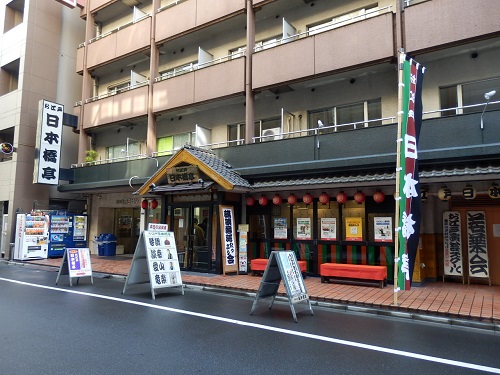
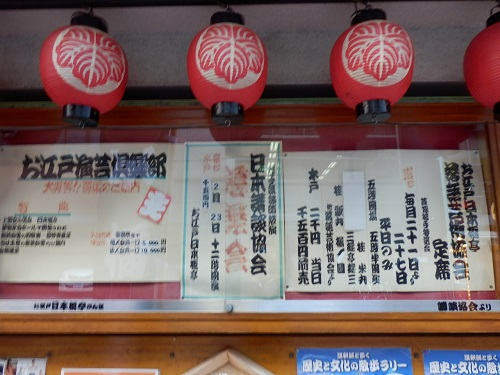

Edo Nihonbashi-tei is conveniently located just a few minutes from Tokyo Metro Mitsukoshimae Station and 6-7 minutes from Nihombashi Station.
![map[1]. jpg](https://en.tokuhain.chuo-kanko.or.jp/archive/map%5B1%5D.jpg)
You can experience traditional performing arts such as talks and Namikyoku, Shinnai, Kouta, Nagauta, Gitayu, etc., including the "Standard Seat" of the Rakugo Arts Council (held every month from 21st to 27th).
The hall is a small hut with about 100 people even if the front of the stage is tatami mats and the back is full with chairs, but I was able to enjoy the live performance after a long absence with the enthusiasm of a young rakugo artist.
Kido Zen depends on the performance, but about 2,000 yen, but if you pay an annual membership fee of 5,000 yen and become a member of the "Edo Performing Arts Club", in addition to "Edo Nihonbashi Tei", Edo Uenohirokoji Tei, Shinjuku Nagatani Hall, Edo Ryogokutei, etc. You can get more than 20 special offers, and most of the other performances are offered by discount tickets.
In addition, `` Walking Rally of History and Culture Walking with Lecturer '', which includes a set of walking around the city and appreciation of vaudeville guided by a lecturer, Rakugo, talks, Namikyoku, magic to Gitayu, Hauta, Ozashiki dance There are also "Edo Performing Arts Japanese Music School" and "Edo Sumo" for sumo lovers from those who want to learn in earnest to become professionals.
Applications for membership are accepted at the Nagatani Corporation office on the left side of the entrance. After joining, you can also enter with the right to use immediately.

Edo Nihonbashi-tei http://ntgp.co.jp/engei/nihonbasi/index.html
[Akira Makibuchi / Sharakusai]
January 27, 2015 14:00
At the Chuo Ward Local Tenmonkan (Time Dome Akashi), a special exhibition "Edo, excavation of play town! ~ Edo Kabuki and Archeology ~ "was started on January 24 (Sat). In Chuo-ku, there was a playhouse called Edo Yoza (later Sanza) from the early Edo period. In this exhibition, distinctive materials from excavated materials from the remains of the playmachi archeological site in Sakaimachi and Fukiya-cho (currently Nihonbashi Ningyocho 3-chome) are displayed. Admission is free until March 8 (Sun). Local Tenmonkan HP Click here>>
 From the Edo period, Nakamura-za in Sakaimachi and Ichimura-za in Fukiya-cho were performed, and there were puppet show huts such as puppet theaters, and the area where teahouses gather around it was formed as a play town . This scene is depicted in the Edo Famous Zoukai. The archaeological site was excavated in one corner near Ichimura-za. From the Edo period, Nakamura-za in Sakaimachi and Ichimura-za in Fukiya-cho were performed, and there were puppet show huts such as puppet theaters, and the area where teahouses gather around it was formed as a play town . This scene is depicted in the Edo Famous Zoukai. The archaeological site was excavated in one corner near Ichimura-za.
From the excavated materials, there are artifacts related to the play, such as wood products with ink or baked, and board materials with the word "Ichimura". Several imitation swords used for play props are also on display. The tools of the puppet show, such as the head and ankles of the puppet show, seem to be traces of the puppeteer.
From the place that seems to be the site of the teahouse, the bottom plate of a curved container marked "tea shop" has been excavated, and pottery pieces with the name of the shop are also displayed. It is unusual that a large number of high-quality products such as Nabeshima ware and colored porcelain were excavated because the teahouse was a customer service place.
There are also iron ware (kanetsuki), red boar (benichoko), bone-crafted hairpins (kanzashi), and kogami (kogai). From the ruins, remain was found, such as stone-framed sewage and sewage gutters, an underground warehouse, and an actor's bath tub or a buried basin. @ Akira Makibuchi
[Tachibana]
January 21, 2015 09:00
In September last year, as the first step to walk on the bridge at the time of the prayer curtain descends, I wrote about the area near "Yanagibashi" written on the January calendar in the novel, but this time in February of the calendar I would like to write along "Asakusabashi" that was written down in March and "Saemonbashi" in March.
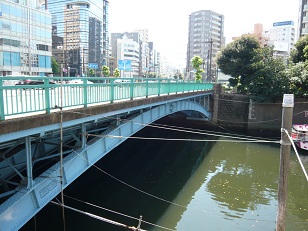
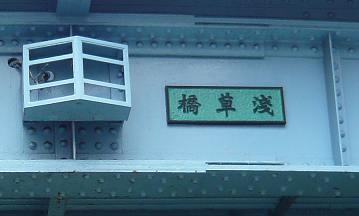 The town in Chuo-ku, which borders Asakusabashi, is now called "Higashibashi 2-chome", but before the house indication was changed, it was "Nihonbashi Ryogoku". From the image of JR. Ryogoku Station and Ryogoku Kokugikan, the place name Ryogoku is often considered to be Sumida-ku, but the original place name "Ryogoku" was in Chuo-ku. Even now, the name of the post office remains as "Ryogoku Post Office". By the way, the Sumida-ku side was once the place name "Higashi Ryogoku". The town in Chuo-ku, which borders Asakusabashi, is now called "Higashibashi 2-chome", but before the house indication was changed, it was "Nihonbashi Ryogoku". From the image of JR. Ryogoku Station and Ryogoku Kokugikan, the place name Ryogoku is often considered to be Sumida-ku, but the original place name "Ryogoku" was in Chuo-ku. Even now, the name of the post office remains as "Ryogoku Post Office". By the way, the Sumida-ku side was once the place name "Higashi Ryogoku".
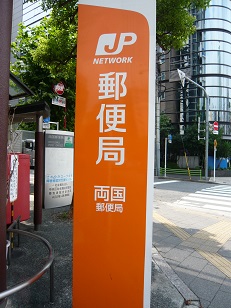 In addition, on the side of Taito Ward side of Asakusabashi, there is a monument of "Asakusa Mitsuke Ruins". Mitsuke was set up in the Edo period to crack down on people heading to Asakusa Kannon and Oshu. In addition, on the side of Taito Ward side of Asakusabashi, there is a monument of "Asakusa Mitsuke Ruins". Mitsuke was set up in the Edo period to crack down on people heading to Asakusa Kannon and Oshu.

In the vicinity of Asakusa Mitsuke, Seizaemon Akamatsu took Taiheiki in the Edo Genroku era and became the birthplace of Edo-lecture, but a monument commemorating this was built in the immovable style of Yakken digging.
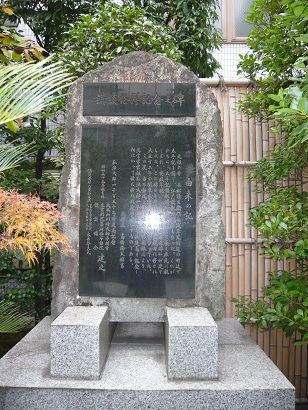
In addition, there is a county mansion on the Chuo-ku side of Asakusabashi in the Edo period, and an explanatory version is built next to the police box, but there is currently Nihonbashi Jogakukan where the site of the county mansion was located. Although it is a women's junior and senior high school integrated school, a new school building was completed in 2009, and this year's entrance examination will be co-educated and the school name will be changed to "Kaichi Nihonbashi Gakuen".
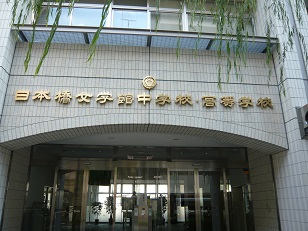
It's Saemon Bridge.
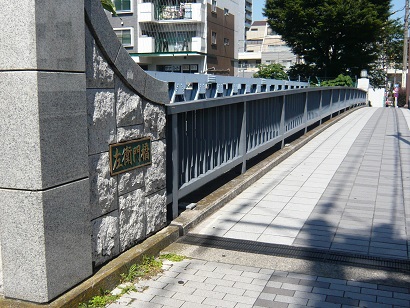 There is also a boarding house between Asakusabashi and Saemonbashi, and a houseboat is moored. There is also a boarding house between Asakusabashi and Saemonbashi, and a houseboat is moored.
(I just saw Saemon Bridge from Asakusabashi. The building on the left is Nihonbashi Jogakukan.)
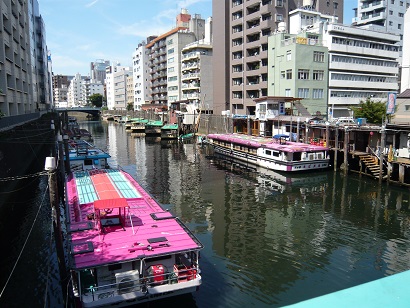 Saemon Bridge is bordered by Taito-ku on the north side, Bakuro-cho on the south side, and Chiyoda-ku on the west side. Saemon Bridge is bordered by Taito-ku on the north side, Bakuro-cho on the south side, and Chiyoda-ku on the west side.
[Nojinya]
January 20, 2015 12:00
On Saturday afternoon, I went to the "Vermeer Hikari Kingdom Exhibition 2015" held in Nihonbashi Muromachi. In this exhibition, you can see the works of Johannes Vermeer (J. Vermeer: 1632-1675), a popular 17th-century Dutch painter in Japan, but I would like to take a closer look at Vermeer's works that I saw at the State Museum of Amsterdam during my previous trip to the Netherlands.
[Mauritz Highs Museum]
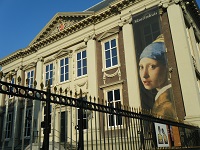 This exhibition was planned in 2012 by Shinichi Fukuoka, a professor at Aoyama Gakuin University (molecular biology) who has also seen Vermeer's originals around the world, and then returned to Japan (Nagoya, Matsuyama, Hiroshima, Nagano, etc.) at 6-chome Ginza from January to July 2012, and then went back to 2 post 0.7 0.7 0 in 1 years. This exhibition was planned in 2012 by Shinichi Fukuoka, a professor at Aoyama Gakuin University (molecular biology) who has also seen Vermeer's originals around the world, and then returned to Japan (Nagoya, Matsuyama, Hiroshima, Nagano, etc.) at 6-chome Ginza from January to July 2012, and then went back to 2 post 0.7 0.7 0 in 1 years.
[Painting Art]
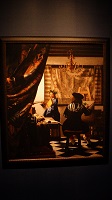 This exhibition is not a moving exhibition of Vermeer's original painting to Japan, but an appreciation of "Re Create Works". According to the commentary on the exhibition, "Re Create" is a digital analysis of the original image data provided by the "Vermeer Center" in Delft, the Netherlands, where Vermeer's hometown, and is reproduced using digital printing technology. Unlike photo reproductions, it is a special canvas with state-of-the-art digital printing, so in some cases, it is possible to faithfully reproduce the colors and textures of the time that Vermeer drew at the time, rather than the originals in museums in Hague and Amsterdam. While being fooled by "Re Create", you can see all 37 Vermeer's works at once at the exhibition in Nihonbashi Muromachi. This exhibition is not a moving exhibition of Vermeer's original painting to Japan, but an appreciation of "Re Create Works". According to the commentary on the exhibition, "Re Create" is a digital analysis of the original image data provided by the "Vermeer Center" in Delft, the Netherlands, where Vermeer's hometown, and is reproduced using digital printing technology. Unlike photo reproductions, it is a special canvas with state-of-the-art digital printing, so in some cases, it is possible to faithfully reproduce the colors and textures of the time that Vermeer drew at the time, rather than the originals in museums in Hague and Amsterdam. While being fooled by "Re Create", you can see all 37 Vermeer's works at once at the exhibition in Nihonbashi Muromachi.
[The woman sitting in front of the Virginal]
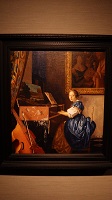 Even though I am a Vermeer fan, I have met directly with some works in museums in Den Hague, Amsterdam, London, Washington, and New York in the past, but in fact, I would like to see all things like Mr. Fukuoka and Mr. Yuriko Kuchiki, the author of the All-Pointed Journey of Vermeer (Shueisha Shinsho) in Paris, the Netherlands, and elsewhere. Even though I am a Vermeer fan, I have met directly with some works in museums in Den Hague, Amsterdam, London, Washington, and New York in the past, but in fact, I would like to see all things like Mr. Fukuoka and Mr. Yuriko Kuchiki, the author of the All-Pointed Journey of Vermeer (Shueisha Shinsho) in Paris, the Netherlands, and elsewhere.
[A girl with pearl earrings]
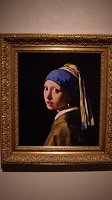
In addition, Vermeer's works are owned by individuals and are not open to the public, and some of them have been stolen from museums in Boston and are still unknown, but can be seen all at this exhibition.
In addition, since it is currently displayed in separate museums, the commonality of the model of painting that can be seen by comparing and comparing paintings of the same theme at the same time, and the supporting role of people I enjoyed a luxurious appreciation opportunity, such as new discoveries about props such as world maps and musical instruments used as After the exhibition, you can receive discounts and other services by presenting an admission ticket for the exhibition at nearby COREDO (Muromachi 1-3, Nihonbashi) and Nihonbashi Mitsui Tower restaurants. I was hungry after the exhibition, so I had dinner at COREDO Muromachi 2 shop, but I hope we can report that story to you separately.
"The Kingdom of Vermeer Light 2015"
Location: 1F, Nihonbashi Muromachi Center Building 3-2-15, Nihonbashi Muromachi, Chuo-ku, 103-0022, Japan (Exit A8, Mitsukoshimae Station)
Date: 1/5 to 3/10 (closed: Monday)
Opening hours; 10:00-19:00
Admission fee: 1,000 yen for adults and 500 yen for elementary and junior high school students.
Voice guide 500 yen.
[Silver]
January 13, 2015 09:00
We have previously posted pine decorations for New Year's Day.
At the "pine decoration" that celebrates the New Year, "how to cut bamboo" is cut diagonally, cut flat on the nodes, and decorate bamboo bamboo grass with pine, It's different at each shop.
When I introduced this year's "Nihonbashi Seven Lucky Gods Tour", a few customers asked me a question.
It seems that Kadomatsu varies from region to region.
First of all, as for the cut, it seems that it has been cut sideways since ancient times, but since the Warring States period, it has been cut diagonally especially in samurai. It seems that this is called "Sogi".
In places where the tradition of Kyoto is valued, bamboo still does not cut diagonally. So, in Kyoto, there are a lot of "sunto".
In addition to these two basic cutting methods, recently, the top of the bamboo is cut sideways and used a bamboo node to leave the shape of the mouth, so that it is not dangerous.
This time, I photographed the pine decorations of a hotel called a Western Ryokan.
This is the Marriott Hotel "Sogi" at the Kyobashi Trust Tower.
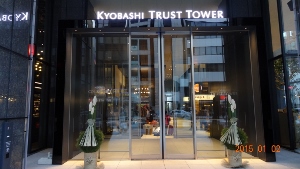
Pine decoration of Ginza Kokusai Hotel. It's a small body.
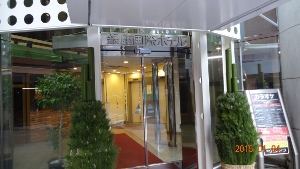
The pine decoration of the Ginza Grand Hotel is "Sogi".

The pine decoration of the Millenium Mitsui Garden Hotel, which opened in December 2014, is Sogi.
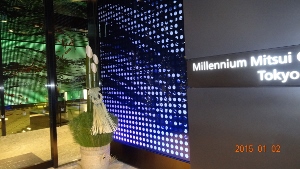
The pine decorations of Mitsui Garden Hotel Ginza Pru Mie are "Sog + Mouth"
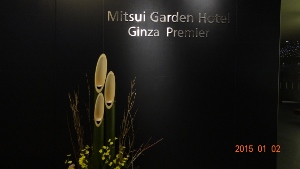
The pine decoration of Courtyard Marriott Ginza Tobu Hotel is "Sunto".
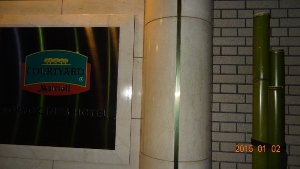
And I went to Uchisaiwai-cho and saw the pine decorations of the oldest hotel in Japan, which celebrated its 125th anniversary this year.
This is "Sagi + Mouth" with the upper part of the bamboo flat, the nodes in the middle, and the lower part with a modest opening of the mouth.
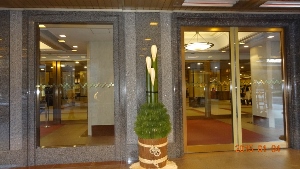
Each hotel seemed to be particular about it, and it was a very interesting exploration.
(This is the past article.)
/archive/2010/01/post-237.html
/archive/2010/01/post-239.html
Hundred Views of Chuo-ku| Ningyocho, Hamacho, Higashinihombashi area| Tsukuda, Tsukishima, Kachidoki and Harumi areas| Nihonbashi, Kyobashi and Yaesu areas| History, culture| Tsukiji, Shintomi, Minato area| Kayabacho, Hatchobori, and Shinkawa areas| Ginza area
Page top▲
[Sam]
January 12, 2015 15:00
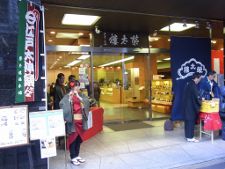 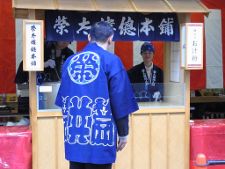
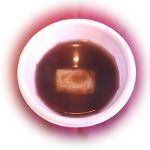 January 11th is the day of mirror opening. January 11th is the day of mirror opening.
At Nihonbashi Eitaro Sohonbu, from 14:00 on the 9th, the first 500 people will behave the annual "mochi soup powder".
This year, since the 11th is the weekend, it will be advanced to Friday on weekdays.
At the store, the sound of the music of the Tokyo Metropolitan Intangible Folk Cultural Property “Edo Dai-Kagura (a popular performing art centered on lion dance and acrobatics, which is said to have a history of 400 years)” is played by Maruichi Senosha, enlivening the New Year mood. I am.
Kagamibiraki is an annual event in which kagami mochi, which had been offered to household miniature shrine and tokonoma as a New Year's decoration, thanks to Shinto and Buddha, praying for sound health, and eating with zoni or soup powder.
Inside the store, there is a fine "Edo" Omochi "<Gufoot decoration>".
"After the Warring States period, in samurai families, rice cakes offered in front of armor are called" armor mochi (decoration) ".
In Edo, the townspeople imitated this, and in merchants did not have armor, so they imitated them in lucky items and decorated them. Our shop has been following this shape since the old days of Edo.
There is an appendix with the content.
Once again, I felt the weight of the long-established succession of Japanese shop curtain, and I had hot soup powder.
|
Links
|
![map[1]. jpg](https://en.tokuhain.chuo-kanko.or.jp/archive/map%5B1%5D.jpg)


 The town in Chuo-ku, which borders Asakusabashi, is now called "Higashibashi 2-chome", but before the house indication was changed, it was "Nihonbashi Ryogoku". From the image of JR. Ryogoku Station and Ryogoku Kokugikan, the place name Ryogoku is often considered to be Sumida-ku, but the original place name "Ryogoku" was in Chuo-ku. Even now, the name of the post office remains as "Ryogoku Post Office". By the way, the Sumida-ku side was once the place name "Higashi Ryogoku".
The town in Chuo-ku, which borders Asakusabashi, is now called "Higashibashi 2-chome", but before the house indication was changed, it was "Nihonbashi Ryogoku". From the image of JR. Ryogoku Station and Ryogoku Kokugikan, the place name Ryogoku is often considered to be Sumida-ku, but the original place name "Ryogoku" was in Chuo-ku. Even now, the name of the post office remains as "Ryogoku Post Office". By the way, the Sumida-ku side was once the place name "Higashi Ryogoku". In addition, on the side of Taito Ward side of Asakusabashi, there is a monument of "Asakusa Mitsuke Ruins". Mitsuke was set up in the Edo period to crack down on people heading to Asakusa Kannon and Oshu.
In addition, on the side of Taito Ward side of Asakusabashi, there is a monument of "Asakusa Mitsuke Ruins". Mitsuke was set up in the Edo period to crack down on people heading to Asakusa Kannon and Oshu.


 There is also a boarding house between Asakusabashi and Saemonbashi, and a houseboat is moored.
There is also a boarding house between Asakusabashi and Saemonbashi, and a houseboat is moored. Saemon Bridge is bordered by Taito-ku on the north side, Bakuro-cho on the south side, and Chiyoda-ku on the west side.
Saemon Bridge is bordered by Taito-ku on the north side, Bakuro-cho on the south side, and Chiyoda-ku on the west side.
 This exhibition is not a moving exhibition of Vermeer's original painting to Japan, but an appreciation of "Re Create Works". According to the commentary on the exhibition, "Re Create" is a digital analysis of the original image data provided by the "Vermeer Center" in Delft, the Netherlands, where Vermeer's hometown, and is reproduced using digital printing technology. Unlike photo reproductions, it is a special canvas with state-of-the-art digital printing, so in some cases, it is possible to faithfully reproduce the colors and textures of the time that Vermeer drew at the time, rather than the originals in museums in Hague and Amsterdam. While being fooled by "Re Create",
This exhibition is not a moving exhibition of Vermeer's original painting to Japan, but an appreciation of "Re Create Works". According to the commentary on the exhibition, "Re Create" is a digital analysis of the original image data provided by the "Vermeer Center" in Delft, the Netherlands, where Vermeer's hometown, and is reproduced using digital printing technology. Unlike photo reproductions, it is a special canvas with state-of-the-art digital printing, so in some cases, it is possible to faithfully reproduce the colors and textures of the time that Vermeer drew at the time, rather than the originals in museums in Hague and Amsterdam. While being fooled by "Re Create",











